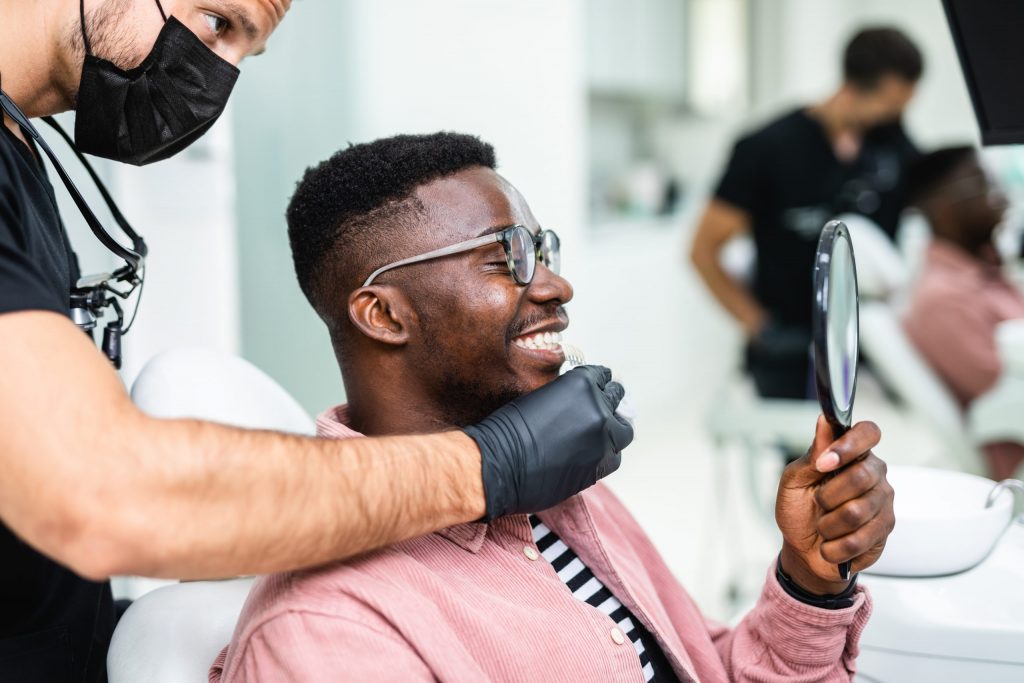Summer Smiles Discount
Save Up to 15% On 1 Treatment Item!
DOWNLOAD COUPONDo you enjoy flossing? More than a third of U.S. adults would rather clean their toilets, prepare their taxes, or tackle some other unpleasant task, according to a survey that made headlines in 2015.
This aversion to flossing is only one factor in the prevalence of periodontitis, or gum disease. People not knowing when to see a periodontist is another.
What is a periodontist? A periodontist is a dentist who is a gum specialist.
Periodontists complete formal education and clinical training beyond what’s needed to become a general dentist. They are skilled experts in preventing, diagnosing, and treating diseases affecting the gum tissue and the other supportive anatomical features (bone, ligaments, and hard tissue called cementum) around the teeth.

Whether or not you floss as everyone should, and whether or not you enjoy it, knowing when to see a periodontist is vital to your good oral health. Keep reading so you can recognize warning signs that warrant a consult with a periodontist.
The sticky bacterial film called dental plaque is naturally present in everyone’s mouth. But when it isn’t removed quickly or thoroughly through regular brushing and flossing, it builds up on teeth and hardens into tartar, causing not only tooth decay but also periodontal disease.
Nearly half of U.S. adults age 30 and older (47.2%) have gum disease in some form. Among adults age 65 and older, the percentage increases (70.1%).
Learning to look for potential indicators of gum disease is a critical part of proper oral hygiene. When ignored or left untreated, periodontal disease can damage not only gum tissue but also the bone supporting the teeth. Tooth loss and bone loss, among other health problems, result.
Here are seven gum disease symptoms periodontists take seriously—and so should you:
This old Latin term for “bad breath” became a household word thanks to ingenious mouthwash marketers. But halitosis is a real condition. When it persists, it can indicate serious oral health problems, including periodontal disease. The disease causes pockets in the gum tissue that harbor bacteria, which release malodorous (bad-smelling) volatile sulfur compounds (VSCs).
Healthy gum tissue is pink and firm. But plaque and tartar collect bacteria that irritate and inflame the gingiva, the area of the gums around the base of the teeth. This condition is called gingivitis. It is the early stage of periodontal disease. It makes gums red, puffy and swollen, and sore and tender.
Healthy gums won’t bleed during routine, proper brushing and flossing. But gums suffering from gingivitis will. Finding blood on your toothbrush or floss may be alarming, but it’s also one of the most common ways people catch gum disease at a point where a dentist or periodontist can help them stop its progress.
Built-up plaque and tartar can cause gums to pull away from the teeth. Gum recession (also called gingival recession) leaves the teeth’s roots exposed. Roots contain thousands of microscopic tubules—canals connected to the pulp, the mass of nerves and blood vessels at a tooth’s center. For this reason, exposed roots can cause notable discomfort and pain due to hot or cold food and drink, among other stimuli.
Once in place, permanent teeth don’t actually grow longer. If they start looking longer, it may be because the gums are receding. The gum tissue is pulling or wearing away, revealing the teeth’s roots. “Looking long in the tooth” is more than a cosmetic issue. It can be a serious threat to good oral health.

A wiggling primary or “baby” tooth is generally little cause for concern; it’s likely just ready to come out. But if a secondary or “adult” permanent tooth is loose, it may be a sign of gum disease. By the time permanent teeth are moving and shifting, gum disease has reached a more serious stage, and it’s time to see a periodontist.
Partial dentures are small sets of replacement teeth attached to a gum-colored base and held together by a metal frame. If dentures start fitting incorrectly and uncomfortably, that change may indicate gum disease, just as when natural teeth start to move. Some clinical research suggests partial dentures, while restoring teeth’s function and appearance, may increase the risk of periodontal disease. But a dentist or periodontist can help denture wearers manage this risk through proper denture and oral hygiene.
As soon as you notice any of these possible warning signs of gum disease, you should schedule an appointment with a periodontist. The sooner periodontists see and diagnose gum disease, the greater their ability to successfully treat it.
What does a periodontist do? They examine the mouths of patients referred to them by a general dentist, then discuss and recommend treatment options. Some courses of periodontal treatment may require only one visit; others may require more.

Here at Penn Dental Family Practice (PDFP), our expert and skilled periodontists use the latest research, state-of-the-art methods and materials, and patient-friendly techniques to treat gum disease and restore mouths to better health. Based on patients’ specific needs, they offer such services as:
If you want to know how to get rid of gum disease, be sure to regularly brush and floss—regardless of whether you enjoy it.
And now that you know when to see a periodontist, schedule an appointment with one at PDFP.
Fill out our online form now, or call us at 215-898-PDFP (7337).